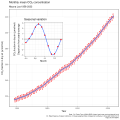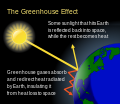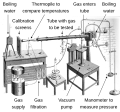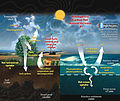Portal:Climate change
The Climate Change Portal Present-day climate change includes both global warming—the ongoing increase in global average temperature—and its wider effects on Earth's climate system. Climate change in a broader sense also includes previous long-term changes to Earth's climate. The current rise in global temperatures is driven by human activities, especially fossil fuel burning since the Industrial Revolution. Fossil fuel use, deforestation, and some agricultural and industrial practices release greenhouse gases. These gases absorb some of the heat that the Earth radiates after it warms from sunlight, warming the lower atmosphere. Carbon dioxide, the primary gas driving global warming, has increased in concentration by about 50% since the pre-industrial era to levels not seen for millions of years. Climate change has an increasingly large impact on the environment. Deserts are expanding, while heat waves and wildfires are becoming more common. Amplified warming in the Arctic has contributed to thawing permafrost, retreat of glaciers and sea ice decline. Higher temperatures are also causing more intense storms, droughts, and other weather extremes. Rapid environmental change in mountains, coral reefs, and the Arctic is forcing many species to relocate or become extinct. Even if efforts to minimize future warming are successful, some effects will continue for centuries. These include ocean heating, ocean acidification and sea level rise. Climate change threatens people with increased flooding, extreme heat, increased food and water scarcity, more disease, and economic loss. Human migration and conflict can also be a result. The World Health Organization calls climate change one of the biggest threats to global health in the 21st century. Societies and ecosystems will experience more severe risks without action to limit warming. Adapting to climate change through efforts like flood control measures or drought-resistant crops partially reduces climate change risks, although some limits to adaptation have already been reached. Poorer communities are responsible for a small share of global emissions, yet have the least ability to adapt and are most vulnerable to climate change. Many climate change impacts have been observed in the first decades of the 21st century, with 2024 the warmest on record at +1.60 °C (2.88 °F) since regular tracking began in 1850. Additional warming will increase these impacts and can trigger tipping points, such as melting all of the Greenland ice sheet. Under the 2015 Paris Agreement, nations collectively agreed to keep warming "well under 2 °C". However, with pledges made under the Agreement, global warming would still reach about 2.8 °C (5.0 °F) by the end of the century. Limiting warming to 1.5 °C would require halving emissions by 2030 and achieving net-zero emissions by 2050. There is widespread support for climate action worldwide. Fossil fuel use can be phased out by conserving energy and switching to energy sources that do not produce significant carbon pollution. These energy sources include wind, solar, hydro, and nuclear power. Cleanly generated electricity can replace fossil fuels for powering transportation, heating buildings, and running industrial processes. Carbon can also be removed from the atmosphere, for instance by increasing forest cover and farming with methods that capture carbon in soil. (Full article...) Selected article –The Quelccaya Ice Cap (also known as Quenamari Ice Cap) is the second largest glaciated area in the tropics, after Coropuna. Located in the Cordillera Oriental section of the Andes mountains in Peru, the cap covers an area of 42.8 square kilometres (16.5 sq mi) with ice up to 200 metres (660 ft) thick. It is surrounded by tall ice cliffs and a number of outlet glaciers, the largest of which is known as Qori Kalis Glacier; lakes, moraines, peat bogs and wetlands are also present. There is a rich flora and fauna, including birds that nest on the ice cap. Quelccaya is an important source of water, eventually melting and flowing into the Inambari and Vilcanota Rivers. A number of ice cores have been obtained from Quelccaya, including two from 1983 that were the first recovered outside of the polar regions. Past climate states have been reconstructed from data in these ice cores; these include evidence of the Little Ice Age, regional droughts and wet periods with historical significance and past and recent El Niño events. The ice cap is regularly monitored and has a weather station. Quelccaya was much larger in the past, merging with neighbouring glaciers during the Pleistocene epoch. A secondary expansion occurred during either the Antarctic Cold Reversal or the Younger Dryas climate anomalies. At the beginning of the Holocene the ice cap shrank to a size smaller than present day; around 5,000 years ago, a neoglacial expansion began. A number of moraines – especially in the Huancané valley – testify to past expansions and changes of Quelccaya, although the chronology of individual moraines is often unclear. (Full article...) Selected picture –The collapse of Larsen B Ice Shelf, showing the diminishing extent of the shelf from 1998 to 2002
WikiProjectsIn the newsAdditional News
Selected biography –Mia "Ma" Amor Mottley, SC MP (born 1 October 1965) is a Barbadian politician and attorney who has served as the eighth prime minister of Barbados since 2018 and as Leader of the Barbados Labour Party (BLP) since 2008. Mottley is the first woman to hold either position. She is also Barbados' first prime minister under its republican system, following constitutional changes she introduced that abolished the country's constitutional monarchy. Mottley has been the Member of Parliament for the constituency of Saint Michael North East since 1994. From 1994 to 2008, she held a succession of ministerial portfolios including the post of Attorney-General of Barbados becoming the first woman to be appointed as such. She is also a member of the Inter-American Dialogue. Mottley was twice the Leader of the Opposition in the House of Assembly of Barbados first from 2008 to 2010 then from 2013 to 2018. In 2018, the Mottley-led BLP won a historic landslide victory in the 24 May general election, securing all 30 seats in the House—making them the first party to accomplish this feat—in addition to winning 72.8 per cent of the popular vote, which is the highest share ever achieved by a party in a general election. (Full article...) General imagesThe following are images from various climate-related articles on Wikipedia.
Did you know –Related portalsWeb resources
Things to do
WikimediaReferences
Discover Wikipedia using portals
|










































































